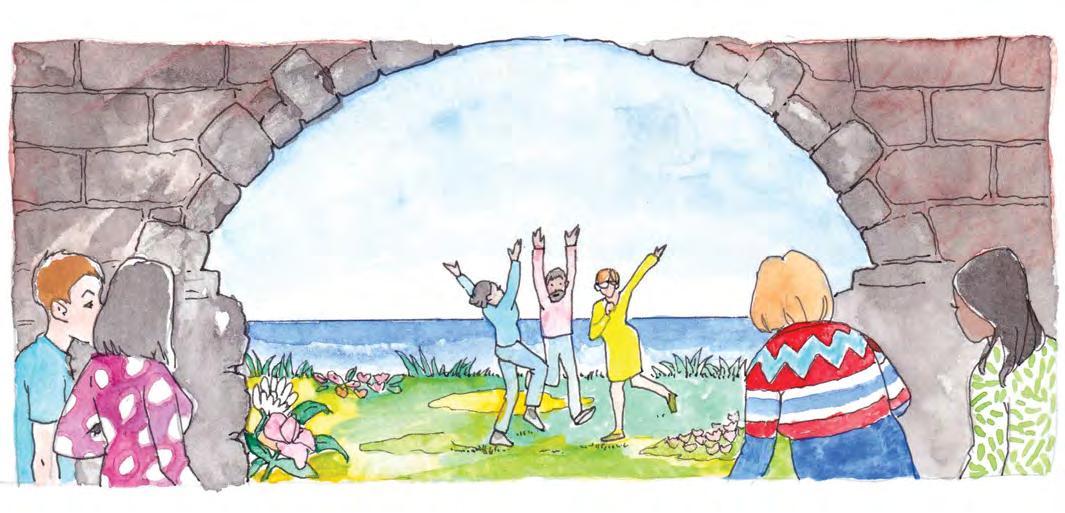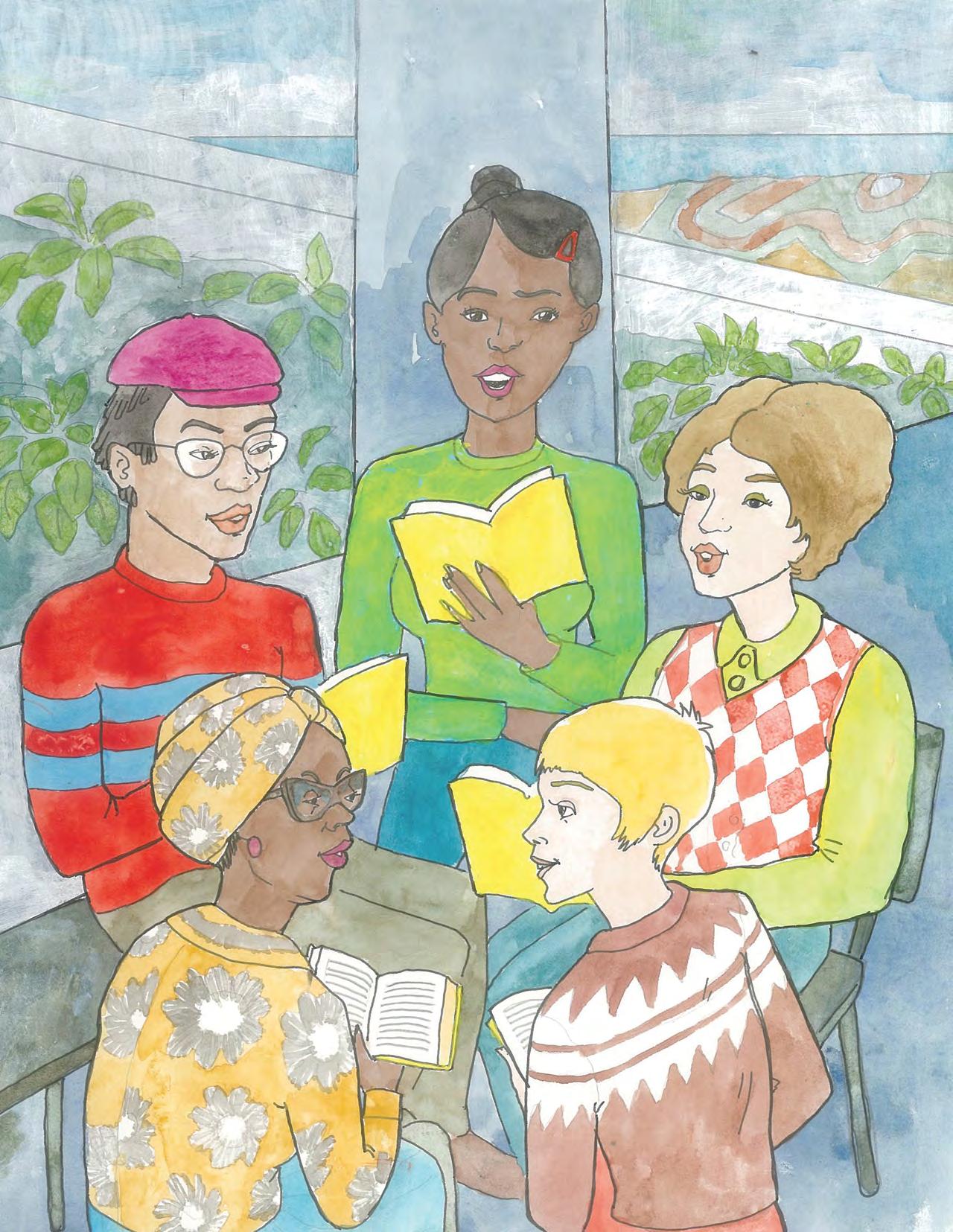
11 minute read
Healing Centered Engagement
A healing centered approach to addressing trauma requires a different question that moves beyond “what happened to you” to “what’s right with you”. It views those exposed to trauma as agents in creating their well-being rather than victims of traumatic events. Healing Centered Engagement is akin to the South African term “Ubuntu”, meaning that humanness is found through our interdependence, collective engagement and service to others. Additionally, healing centered engagement offers an asset-driven approach aimed at the holistic restoration of young people’s well-being. The healing centered approach comes from the idea that people are not harmed in a vacuum, and well-being comes from participating in transforming the root causes of the harm within institutions. Healing centered engagement also advances the move to strengths-based care and away from the deficit-based mental health models that drive therapeutic interventions. Four key elements of healing centered engagement may overlap with current trauma informed practices but offer several vital distinctions. 1. Healing centered engagement is explicitly political rather than clinical. Communities and individuals who experience trauma are agents in restoring their well-being. This subtle shift suggests that healing from trauma is found in awareness and actions that address the conditions that created the trauma in the first place. 2. Healing centered engagement is culturally grounded and views healing as the restoration of identity. It uses culture to ground young people in a solid sense of meaning, self-perception, and purpose. This process highlights the intersectional nature of identity and how culture offers a shared experience, community and sense of belonging. Healing is experienced collectively and is shaped by shared identities such as race, gender, or sexual orientation. 3. Healing centered engagement is asset driven and focuses on well-being rather than symptoms we want to suppress. An asset-driven strategy acknowledges that young people are much more than the worst thing that happened to them. It builds upon their experiences, knowledge, skills and curiosity as positive traits to be enhanced. 4. Healing centered engagement supports adult providers with their own healing. Adult providers need healing too! Healing centered engagement requires that we consider how to support adult providers in sustaining their own healing and well-being. We cannot presume that adulthood is a final, “trauma-free” destination.
Principles:
Advertisement
● Move to “what's right with you?” ● Focus is political, not clinical–what caused the trauma in the first place? ● Healing happens in the restoration of identity ● Focuses on assets. What is the well-being we want versus symptoms we don’t want ● Centers the provider’s own healing
Practices:
● Build empathy ● Encourage dreams and imagination ● Build critical reflection and loving action
(Adapted from Shawn Ginwright’s article on Healing Centered Engagement)
Healing and Hospitality
Paula took out her phone and searched for a verse of scripture. “I’d like us to go through Psalm 139. It is a wonderful resource for us as we explore this topic. It talks about how God knows me, you, all of us! Stop me and comment when something strikes you.”
Psalm 139
The Inescapable God
To the leader. Of David. A Psalm. 1 O Lord, you have searched me and known me. 2 You know when I sit down and when I rise up; you discern my thoughts from far away. 3 You search out my path and my lying down and are acquainted with all my ways. 4 Even before a word is on my tongue,
O Lord, you know it completely. 5 You hem me in, behind and before, and lay your hand upon me. 6 Such knowledge is too wonderful for me; it is so high that I cannot attain it. 7 Where can I go from your spirit?
Or where can I flee from your presence? 8 If I ascend to heaven, you are there; if I make my bed in Sheol, you are there. 9 If I take the wings of the morning and settle at the farthest limits of the sea, 10 even there your hand shall lead me, and your right hand shall hold me fast.
Amy smiled. “I like this. Even if we could travel to the furthest corner of the universe at the speed of light, we would find the Lord there, waiting to guide and uphold us.”
11 If I say, “Surely the darkness shall cover me, and night wraps itself around me,” 12 even the darkness is not dark to you; the night is as bright as the day, for darkness is as light to you.

Joel raised a hand. “This is so reassuring. I can't escape from God's presence. I am never outside the presence and love of God. Even in the darkest times and places like Sheol - the underworld...the world of the dead - darkness covers me, and night wraps itself around me, but God is there and is holding me. God can handle everything that happens. For God, darkness is not dark. The night is as bright as day.” Amy nodded. “Yes, the psalmist, David, really shows three of the attributes in the nature of God; God’s omniscience, God’s omnipresence, and God’s omnipotence.”
13 For it was you who formed my inward parts; you knit me together in my mother’s womb. 14 I praise you, for I am fearfully and wonderfully made.
Wonderful are your works; that I know very well. 15 My frame was not hidden from you when I was being made in secret, intricately woven in the depths of the earth. 16 Your eyes beheld my unformed substance.
In your book were written all the days that were formed for me, when none of them as yet existed. “... For God, darkness is not dark. The night is as bright as day.”
Amy piped in. “ I love this! God made me good! I am fearfully and wonderfully made. God knows me through and through--before I was born and through all the days that were formed for me. When translated in Hebrew, ‘fearfully’ means ‘with great reverence, heart-felt interest, and with respect’.” Paula nodded. “Yes, God has given me everything I need to be a loving, caring person. But it’s up to me to use it.”
17 How weighty to me are your thoughts, O God!
How vast is the sum of them! 18 I try to count them—they are more than the sand;
I come to the end—I am still with you.
Paula interrupted her reading and paused. She smiled at the others. “We can't always understand God's ways. But God is with us even when we don't understand why things are happening.”
19 O that you would kill the wicked, O God, and that the bloodthirsty would depart from me— 20 those who speak of you maliciously and lift themselves up against you for evil! 21 Do I not hate those who hate you, O Lord?
And do I not loathe those who rise up against you? 22 I hate them with perfect hatred;
I count them my enemies.
Joel nodded as Paula read this part. “What happened to me is not fair. There is evil in the world and it makes me angry and sad. Those things make God angry and sad, too.”
23 Search me, O God, and know my heart; test me and know my thoughts. 24 See if there is any wicked way in me, and lead me in the way everlasting.
Amy looked at her friends. “This psalm evokes for me a call to true hospitality. Not the hospitality that seeks to impress or entertain. Rather, a kind of hospitality that welcomes the stranger into a safe, unassuming, and nonjudgmental space. Regardless of the past relationship or previous understanding of an individual, providing true hospitality allows them the opportunity to change, grow, and wrestle with their present selves.” Paula smiled. “Yes, it listens and receives them as they are and not whom they were thought or supposed to be. They may need to grieve for the person they used to be while accepting who they are now, and the caregiver or family may need to do the same. I imagine that not all of Moses’ or Saul’s friends and family adjusted to their changes in identity, personality, and purpose without some challenge. There must be space to explore and adjust to the changes thrust upon them. Listen to what Henri J. M. Nouwen had to say: The paradox of hospitality is that it wants us to create emptiness, not a fearful emptiness, but a friendly emptiness where strangers can enter and discover themselves as created free; free to sing their own songs, speak their own languages, dance their own dances; free also to leave and follow their own vocations. Free to be themselves (1986).

How we live
By Gary Gunderson
There is no reason, really, why we humans would have developed as we have on our little planet with such a little star off in the far corner of cold and empty vastness. No reason why a species would emerge with such tender hearts, easily damaged with such enduring bruises. Doesn’t seem like a winning strategy compared to the super successful forms of life like bacteria or the virus. They flourish with stunning creativity, adapting and borrowing, discarding anything at all that doesn’t work just a tiny bit better. Never bothered with any one of their sisters, much less parents, they just replicate again and again and again, each one an experiment unlikely to work, so easily dismissed and left behind. Most of what we call life works that way, everything food for the other, nothing wasted, all consumed, and so it goes.
Not so with us humans, each begun in a ridiculously awkward process mingling primal energy with the most tender hopefulness we dare call love. Two cells share their essence, unique in all the galaxy, held warm inside, the mother humming, as they arrange themselves strangely and wonderfully made. Almost all of the time, a wriggly slippery wailing child pushed as if all the universe was pushing down and out into the light of some ragged gaggle we call family, not knowing all the appropriate names for all the people who are within caring range. Utterly and totally dependent for every possible tangible and intangible requirement to stay alive. Not remotely “grown” for decades, some would say never as even near the later days of that one life, still dependent on others for damn near everything. What a curious way for a species to hope to make it on the planet.
No wonder we hurt each other so easily, casually and without end; we need each other so much, as if we have no skin, totally exposed. Only together, skin to skin, eye to eye, gesture to gesture, tenderness to tenderness, do we have any chance at all. No wonder we hurt each other so easily.
The mystery is that even one generation finds a way at all. But we do and have over and over again, back to when all we had was just enough language to come together to make fire. Always coming together, congregating, talking not just about meat and water but meaning and hope; what holds our fragile Spirit alive enough for one more day, maybe another season, maybe another life. We talk and find our way, we find our capacity, how to be part of the larger life beyond our own bag of skin, and how to imagine a hope that might live beyond us. The human way of tenderness and Spirit. Even, maybe especially, in the dark time we live.


CHAPTER FOUR

Connection and Companionship
Nurturing the Tree of Community
Amy was at the seminary. In one of her pastoral counseling classes, the professor had divided them into small groups, each with a case study to read and discuss. They were tasked to look for moments of connection and examples of companionship in all the stories and to do this by working through a reflective process together. The group was diverse. Zachary, the young, idealistic associate pastor, sat next to her. Then there was Debra, who was deeply spiritual and showed unconditional love and commitment to homeless people with persistent and severe mental illness and substance use disorders (SUD). She had grown up privileged and comfortable, but a life crisis had opened her eyes to the desperate state of the homeless, which has now become her life’s work.
Thea, much older than the rest, had worked in public health for many years and now, as director of her organization, was eager to complete her studies. As a young woman of color, she had been unjustly excluded from pursuing her dreams of higher education. Her lens was unapologetically one of social justice, advocacy and structural issues, but she was always able to articulate her observations and insights with wisdom and grace. Alex, who had experienced and suffered gender identity issues for many years and now identified as non-binary, brought a perspective and energy focused on gender, identity and relationships, which challenged the group to be sensitive and awake to discriminatory patterns of behavior and prejudice. Amy saw herself as young and socially conscious. As a pastor’s child, she had actively fought against her religious upbringing, wanting to find her own way. Still, after working in local social change organizations, she realized she wanted to return to school—to the seminary to blend her faith and social activism in more explicit ways. The Black Lives Matter movement significantly shaped her formative years, and she often led discussions on racism and feminism in her groups. Today she wanted to ensure that she fully listened to the others and held the space open for connection. The story the group was given to work with was written by Bree Ferguson. Debra read it aloud while the others listened or made notes in their books.










